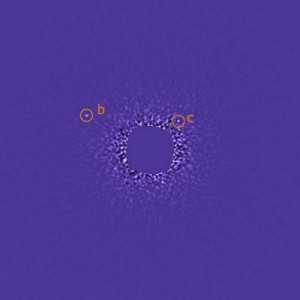 In astronomical news this week:
In astronomical news this week:
For the first time, images have been captured of a planetary system orbiting another star.
Extra-solar planets have been discovered before (notably by New Zealand’s own MOA group). But the techniques used have involved inferences such as gravitational wobbles or subtle dimming of the stars’ brightness, rather than direct imaging of the planets themselves.
Researchers from the Gemini Observatory and W.M. Keck Observatory on Hawaii’s Mauna Kea are using adaptive optics and infrared imaging to complete a survey of 80 young, dusty stars in the solar neighborhood. The fact that these planets were found after only a few stars had been studied may indicate that Jupiter-sized planets are common around stars more massive than the Sun.
The picture here is the discovery image in the near-infrared (photo credit: Gemini Observatory) with two of the three planets circled and labeled. The star — HR 8799 — is around 130 light years away, and is actually faintly visible to the naked eye (the scientists thoughtfully included star finder charts with their press release).